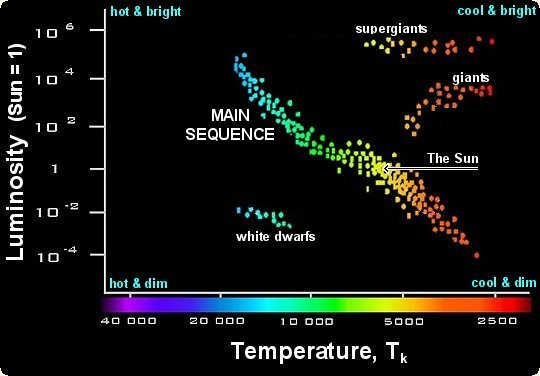Hertzsprung Russell Diagram

The HR diagram is the "Rosetta Stone" of stellar astronomy. It was created in 1910 by Ejnar Hertzsprung and Henry Norris Russell. It plots a star's luminosity against its surface temperature. As simple as that sounds, it is the key to understanding stellar evolution. Luminosity is a rate of energy output, i.e. wattage. The Sun's output is about 4 x 1026 watts. The surface temperature of a star and its color are directly tied to each other. Hotter stars have a peak color output toward the blue end of the spectrum. Cooler stars peak in the red. Other temperatures/colors are between but if it peaks in the middle (green) it is also putting out lots of blue and red, and our brains mix them together to make white.  Stars are grouped into
spectral types which can be viewed as either temperature or color groupings that were created by Annie Jump Cannon in the 1890's. From hottest to
coolest the group designations are: O B A F G K M. The order is remembered by students
with the mnemonic "Oh Be A Fine (Girl or Guy) Kiss Me."
Stars are grouped into
spectral types which can be viewed as either temperature or color groupings that were created by Annie Jump Cannon in the 1890's. From hottest to
coolest the group designations are: O B A F G K M. The order is remembered by students
with the mnemonic "Oh Be A Fine (Girl or Guy) Kiss Me."
The majority of stars lie roughly on a line from hot and bright, to cool and dim. This line is known as the "main sequence." Mathematically speaking, stars live most of their lives on the main sequence. It is during this part of a star's life that it is turning hydrogen into helium in the core. Most stars begin their lives hot and bright on the map, then progress to a semi-permanent address farther down on the main sequence. What happens later depends on the star's mass. For example, the Sun will eventually move upwards and to the right, into the realm of the red giants. Then it will move up and to the left, and then drop straight down into the graveyard of white dwarfs. |